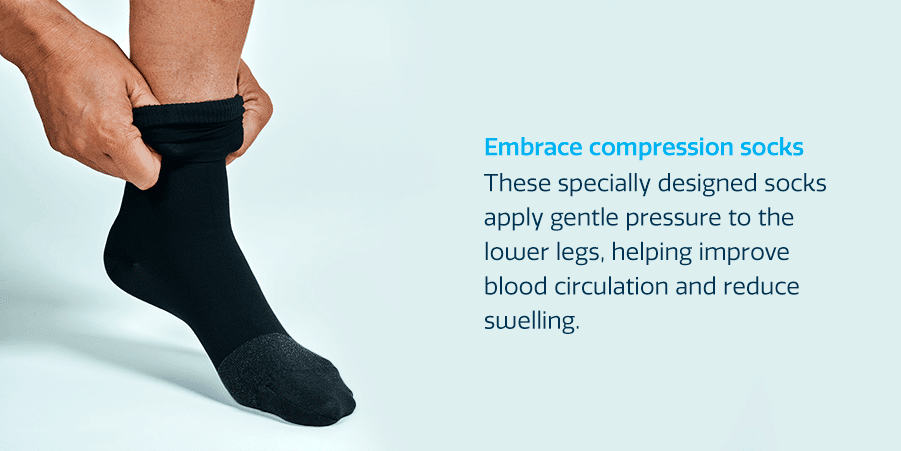Do your feet swell when you travel by car? Yes, it’s a common problem. Many people experience foot swelling, also known as edema, during long car rides. This article will explore the reasons behind car travel swelling causes and what you can do to find relief. We’ll discuss everything from poor circulation car rides to the role of dehydration foot swelling travel, and how things like compression socks car travel edema can help.

Image Source: fasafw.com
Deciphering the Reasons Behind Foot Swelling in Cars
Several factors contribute to foot edema car trips. Let’s delve into the common car travel swelling causes:
The Impact of Inactivity
Prolonged sitting swelling feet is a primary culprit. Sitting for extended periods, especially in a confined space, hinders the natural pumping action of your leg muscles. These muscles usually help push blood back up towards your heart. When they’re inactive, blood can pool in your lower extremities, leading to car journey ankle swelling and foot swelling.
Gravity’s Role
Gravity naturally pulls fluids downwards. When you sit for long hours, gravity increases the pressure in the veins of your legs and feet. This increased pressure can force fluid out of your blood vessels and into the surrounding tissues, causing swelling.
Dehydration’s Hidden Impact
Dehydration foot swelling travel might seem counterintuitive, but it’s a real factor. When you’re dehydrated, your body tries to conserve water. This can lead to an increase in sodium concentration in your blood. Higher sodium can cause your body to retain even more fluid, worsening swelling.
Salt Intake
Salty foods are travel staples, and they are one of the travel-related edema feet causes. High salt intake prompts the body to hold onto water, exacerbating swelling. Processed snacks and fast food, common choices on road trips, are often loaded with sodium.
Poor Circulation Explained
Poor circulation car rides contribute significantly to the problem. Conditions that impair blood flow, such as varicose veins or chronic venous insufficiency, can make you more susceptible to leg swelling driving long distances. The prolonged sitting further compounds these existing circulation issues.
The Threat of Deep Vein Thrombosis
Deep vein thrombosis car travel feet (DVT) is a serious concern. DVT is a blood clot that forms in a deep vein, usually in the leg. Prolonged immobility during long car trips increases the risk of DVT. Swelling is a common symptom of DVT, along with pain, warmth, and redness. If you suspect DVT, seek immediate medical attention.
Spotting the Symptoms of Foot Swelling
It’s important to recognize the signs of edema related to travel:
- Visible swelling in your feet, ankles, and lower legs
- Tight or stretched skin in the affected areas
- Shoes or socks feeling tighter than usual
- Aching or throbbing sensation in your legs and feet
- Pitting edema (when you press on the swollen area, it leaves a temporary indentation)
Practical Steps for Relief and Prevention
Don’t let swollen feet ruin your road trip. Here are some ways to manage and prevent travel-related edema feet:
Move Regularly
- Scheduled Stops: Plan to stop every 1-2 hours. Get out of the car and walk around for at least 5-10 minutes.
- In-Seat Exercises: While seated, perform ankle pumps (point your toes up and down) and calf raises. Rotate your ankles to improve circulation.
Hydrate Diligently
- Water is Key: Drink plenty of water throughout your journey. Avoid sugary drinks and limit caffeine, as they can contribute to dehydration.
- Electrolyte Balance: Consider electrolyte-rich drinks to help regulate fluid balance.
Watch Your Salt Intake
- Pack Smart: Bring your own snacks with low sodium content. Fruits, vegetables, and homemade trail mix are good options.
- Read Labels: Be mindful of the sodium content in restaurant meals and packaged foods.
Elevate Your Feet
- During Breaks: When you stop, elevate your feet above your heart level. This helps drain excess fluid.
- In the Car: If possible, use a small cushion or bag to slightly elevate your feet while sitting.
Embrace Compression Socks
- The Benefits: Compression socks car travel edema reduce swelling by supporting your veins and improving blood flow. They gently squeeze your legs, helping to prevent fluid from pooling.
- Choosing the Right Socks: Look for graduated compression socks that provide the most pressure at the ankle and gradually decrease towards the knee. Consult a healthcare professional for guidance on the appropriate compression level.
Strategic Clothing Choices
- Loose Fit: Wear loose-fitting clothing that doesn’t constrict your circulation.
- Comfortable Shoes: Opt for comfortable shoes with good support. Avoid tight-fitting shoes that can restrict blood flow.
Pre-Trip Preparation
- Consult Your Doctor: If you have a history of circulation problems, consult your doctor before embarking on a long car trip. They may recommend specific measures to prevent swelling and blood clots.
- Consider Blood Thinners: For individuals at high risk of DVT, a doctor might prescribe blood thinners.
Home Remedies for Post-Trip Swelling
If your feet are swollen after your car journey, try these home remedies:
- Rest and Elevation: Lie down and elevate your feet above your heart for 30-60 minutes.
- Ice Packs: Apply ice packs to the swollen areas for 15-20 minutes at a time.
- Gentle Massage: Gently massage your feet and legs to promote circulation.
- Epsom Salt Soak: Soak your feet in warm water with Epsom salts for 15-20 minutes. Epsom salts can help reduce inflammation and swelling.
Table: Comparing Causes and Solutions for Foot Swelling During Car Travel
| Cause | Solution |
|---|---|
| Prolonged Sitting | Regular breaks, in-seat exercises |
| Gravity | Elevate feet during breaks, slight elevation in car |
| Dehydration | Drink plenty of water, electrolyte balance |
| High Salt Intake | Low-sodium snacks, read food labels |
| Poor Circulation | Compression socks, consult doctor |
| Potential DVT | Seek immediate medical attention |
When to Seek Medical Attention
While foot swelling during car travel is usually harmless, it’s crucial to know when to seek medical advice. Consult a doctor if:
- Swelling is severe or doesn’t improve with home remedies
- You experience pain, warmth, or redness in your legs
- You have shortness of breath or chest pain (possible signs of a blood clot traveling to the lungs)
- You have a history of heart disease, kidney disease, or other medical conditions that can cause edema
Fathoming Deep Vein Thrombosis (DVT)
As mentioned earlier, DVT is a serious concern, especially during long periods of immobility. Here’s a deeper look:
Risk Factors for DVT
- Prolonged sitting or immobility
- History of DVT or pulmonary embolism
- Recent surgery or injury
- Pregnancy or recent childbirth
- Use of oral contraceptives or hormone replacement therapy
- Cancer
- Obesity
- Smoking
- Age over 60
- Certain genetic conditions
Recognizing DVT Symptoms
- Swelling in one leg (usually the calf)
- Pain or tenderness in the leg
- Warm skin on the leg
- Red or discolored skin on the leg
- Enlarged veins near the surface of the skin
DVT Prevention Strategies
In addition to the general measures for preventing foot swelling, consider these DVT-specific strategies:
- Anticoagulant Medication: If you’re at high risk, your doctor may prescribe anticoagulant medication (blood thinners) to prevent blood clot formation.
- Intermittent Pneumatic Compression (IPC) Devices: These devices use inflatable cuffs around your legs to improve blood flow. They may be recommended for individuals at very high risk of DVT.
Compression Socks: Your Travel Companion
Compression socks are a cornerstone of preventing and managing travel-related edema. Here’s a detailed look:
How Compression Socks Work
Compression socks apply graduated pressure to your legs, with the highest pressure at the ankle and gradually decreasing pressure towards the knee. This pressure helps:
- Improve blood flow by squeezing veins and pushing blood back towards the heart
- Reduce swelling by preventing fluid from pooling in the lower extremities
- Support veins and prevent them from stretching or becoming damaged
- Reduce the risk of blood clots
Choosing the Right Compression Level
Compression levels are measured in millimeters of mercury (mmHg). The appropriate compression level depends on your individual needs and risk factors. Common compression levels include:
- 8-15 mmHg: Mild compression, suitable for everyday wear and minor swelling.
- 15-20 mmHg: Moderate compression, ideal for travel and mild to moderate swelling.
- 20-30 mmHg: Firm compression, often recommended for varicose veins, lymphedema, and more significant swelling.
- 30-40 mmHg: Very firm compression, typically prescribed by a doctor for specific medical conditions.
Tips for Wearing Compression Socks
- Put them on in the morning: Swelling is usually minimal in the morning, making it easier to put on the socks.
- Roll them on: Roll the sock down to the heel, then gradually roll it up your leg, ensuring it’s smooth and evenly distributed.
- Avoid wrinkles: Wrinkles can create pressure points and cause discomfort.
- Wash them regularly: Wash compression socks by hand or in a gentle machine cycle. Avoid using fabric softener, as it can damage the elastic fibers.
- Replace them periodically: Compression socks lose their elasticity over time. Replace them every 3-6 months, or as needed.
FAQ: Addressing Common Concerns
- Why do my feet swell more on some car trips than others? Factors like hydration levels, salt intake, the duration of the trip, and your underlying health can all contribute to variations in swelling.
- Can I wear compression socks overnight? It’s generally not recommended to wear compression socks overnight unless specifically advised by your doctor.
- Are there any alternatives to compression socks? Support stockings can offer a mild degree of compression, but they are generally less effective than graduated compression socks.
- Can certain medications cause foot swelling during car travel? Some medications, such as certain blood pressure medications and hormone therapies, can increase the risk of edema. Discuss your medications with your doctor.
- Is foot swelling during car travel a sign of a serious medical condition? While usually harmless, persistent or severe swelling, especially if accompanied by other symptoms, should be evaluated by a doctor to rule out underlying medical conditions.
- What is the best way to elevate my feet in the car? Use a small pillow, blanket, or even a bag to prop up your feet slightly. The key is to raise them above the level of your heart.
By taking proactive steps to prevent and manage foot swelling during car travel, you can ensure a more comfortable and enjoyable journey. Remember to stay hydrated, move regularly, and consider compression socks as your trusty travel companion. If you have any concerns, consult your doctor for personalized advice.

Hi, I’m Candace Wafford, a travel and food blogger based in Lexington, Kentucky. As a corporate traveler, I’ve had the chance to explore a lot of places, but now I’m on a mission to travel full-time. My goal? To figure out how to take my cat along for the adventure! Here at destinationdorworth.com, I share my experiences and tips on outdoor activities, travel, and of course, the best food spots I come across. I hope my blog inspires you to explore more and eat well on your journeys!
